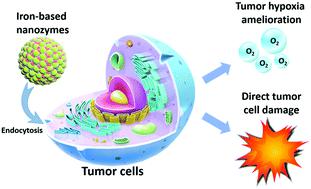当前位置:
X-MOL 学术
›
Nanoscale Horiz.
›
论文详情
Our official English website, www.x-mol.net, welcomes your
feedback! (Note: you will need to create a separate account there.)
State-of-the-art iron-based nanozymes for biocatalytic tumor therapy
Nanoscale Horizons ( IF 8.0 ) Pub Date : 2019-11-05 , DOI: 10.1039/c9nh00577c Menghuan Li 1, 2, 3, 4, 5 , Hui Zhang 3, 4, 6, 7, 8 , Yanhua Hou 4, 9, 10, 11 , Xuan Wang 1, 2, 3, 4 , Chencheng Xue 1, 2, 3, 4 , Wei Li 3, 4, 6, 7, 8 , Kaiyong Cai 2, 3, 4, 12, 13 , Yanli Zhao 5, 14, 15, 16 , Zhong Luo 1, 2, 3, 4
Nanoscale Horizons ( IF 8.0 ) Pub Date : 2019-11-05 , DOI: 10.1039/c9nh00577c Menghuan Li 1, 2, 3, 4, 5 , Hui Zhang 3, 4, 6, 7, 8 , Yanhua Hou 4, 9, 10, 11 , Xuan Wang 1, 2, 3, 4 , Chencheng Xue 1, 2, 3, 4 , Wei Li 3, 4, 6, 7, 8 , Kaiyong Cai 2, 3, 4, 12, 13 , Yanli Zhao 5, 14, 15, 16 , Zhong Luo 1, 2, 3, 4
Affiliation

|
Biocatalytic tumor therapy with artificial nanoscale enzyme-mimics (nanozymes) is an emerging strategy for the therapeutic intervention of a variety of malignant conditions, which can provide the combined benefits of enzyme-dependent biocatalytic activities and nanotechnology. Generally, these novel nanocatalysts employ particular multivalent ions as the catalytic center; they have demonstrated high catalytic efficiencies, due to which they are even more potent than natural enzymes, and they also exhibit better in vivo stability, functional versatility and lower manufacturing cost. It is well established that a malignant tumor has many enzymatic mutations, which provides ample opportunities for the development of biocatalytic tumor therapy with nanozymes. Most of the current research in this area revolves around iron-based nanostructures due to their easy manufacturing process, intrinsic biocompatibility, promising physical properties, and versatile and efficient catalytic activity. A great variety of studies in the recent decade have consistently demonstrated the translational potential of iron-based nanozymes for tumor therapy. Therefore, it would be of great practical significance to summarize the previous reports on the treatment-facilitative effects and tumor cell-damaging mechanisms of iron-based nanozymes, which primarily include tumor hypoxia amelioration, Fenton-enhanced ROS damage and the activation of the ferroptosis pathway. Additionally, we also discuss the critical issues that may affect their clinical translation and future development. We hope that these iron-based nanozymes can overcome the limitations of conventional therapies and open new avenues for tumor treatment.
中文翻译:

用于生物催化肿瘤治疗的最先进的铁基纳米酶
人工纳米级酶模拟物(纳米酶)的生物催化肿瘤疗法是治疗各种恶性疾病的新兴策略,可提供酶依赖性生物催化活性和纳米技术的综合优势。通常,这些新型纳米催化剂采用特定的多价离子作为催化中心。它们表现出很高的催化效率,因此它们比天然酶更有效,并且在体内也表现出更好的活性稳定性,多功能性和较低的制造成本。公认的是,恶性肿瘤具有许多酶促突变,这为开发具有纳米酶的生物催化肿瘤疗法提供了充足的机会。由于其易于制造的过程,固有的生物相容性,有希望的物理性质以及广泛而有效的催化活性,该领域中的大多数当前研究都围绕铁基纳米结构。近十年来的大量研究一致地证明了铁基纳米酶在肿瘤治疗中的翻译潜力。因此,总结以往有关铁基纳米酶的治疗促进作用和肿瘤细胞破坏机制的报道具有重要的现实意义,其中主要包括肿瘤缺氧的改善,芬顿增强的ROS损伤和肥大症通路的激活。此外,我们还将讨论可能影响其临床翻译和未来发展的关键问题。我们希望这些铁基纳米酶能够克服传统疗法的局限性,并为肿瘤治疗开辟新的途径。
更新日期:2019-11-05
中文翻译:

用于生物催化肿瘤治疗的最先进的铁基纳米酶
人工纳米级酶模拟物(纳米酶)的生物催化肿瘤疗法是治疗各种恶性疾病的新兴策略,可提供酶依赖性生物催化活性和纳米技术的综合优势。通常,这些新型纳米催化剂采用特定的多价离子作为催化中心。它们表现出很高的催化效率,因此它们比天然酶更有效,并且在体内也表现出更好的活性稳定性,多功能性和较低的制造成本。公认的是,恶性肿瘤具有许多酶促突变,这为开发具有纳米酶的生物催化肿瘤疗法提供了充足的机会。由于其易于制造的过程,固有的生物相容性,有希望的物理性质以及广泛而有效的催化活性,该领域中的大多数当前研究都围绕铁基纳米结构。近十年来的大量研究一致地证明了铁基纳米酶在肿瘤治疗中的翻译潜力。因此,总结以往有关铁基纳米酶的治疗促进作用和肿瘤细胞破坏机制的报道具有重要的现实意义,其中主要包括肿瘤缺氧的改善,芬顿增强的ROS损伤和肥大症通路的激活。此外,我们还将讨论可能影响其临床翻译和未来发展的关键问题。我们希望这些铁基纳米酶能够克服传统疗法的局限性,并为肿瘤治疗开辟新的途径。











































 京公网安备 11010802027423号
京公网安备 11010802027423号